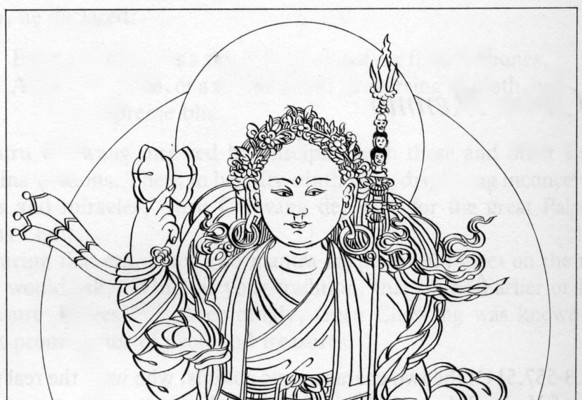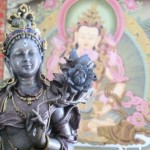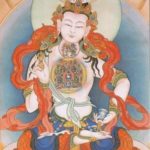In another act of inspiring leadership, the 17th Karmapa (1) has announced that he will restore the full ordination of nuns in Tibet.
The growing presence of female leaders in Tibetan Buddhism is taking place at an unprecedented level throughout the world. The Karmapa’s recent announcement is a confirmation that Buddhism worldwide is recognizing the need to support this activity by granting support for nuns. While full monastic ordination for monks is available in Buddhist countries, full ordination for women has been available in only a few of them. The full ordination of nuns are known as taking bhikṣuṇī vows( or Tibetan – dge-slong-ma) .
Tibetan Nuns
This January, 2015, the Karmapa announced that he will restore the full ordination of nuns to Tibet, in a process that will unfold over the next ten years. The Karmapa plans that this will unfold after a traditional period of first taking novice vows and training vows in order to prepare for full ordination. Stating that it is an “unfortunate situation for Buddhism in general,” not to offer full ordination to female monastics.
Women’s monastic ordination is one of many types of roles of religious leadership that women will contribute to Tibetan Buddhism. Throughout its history women also continued to contribute religious leadership outside monastic institutions. For example, last year I heard Khenpo Sodargye speak. He is a leader of the Larung gar a Buddhist community in North Eastern Tibet. I asked him about the role of women in his community and in his travels throughout China. He replied that these days he saw more Khenmos (female Buddhist scholars) than there were Khenpos (male Buddhist scholars) during his travels!
Historically women in have played other decisive roles in Tibetan Buddhism. Without knowledge of these activities it is impossible to comprehend Tibetan history. Yet, historical documentation is sparse. However there are accounts of female religious leadership in biographical narratives, institutional records, literature and political documents.
For example, the female patron of an influential eighteenth century Nyingma teacher, Jigme Lingpa, was the queen of sDe-dge and her patronage played a decisive role in ensuring the propagation of his activity and printing of his works. Likewise women have also played roles as vow-carrying, non-celibate, clerical leaders. These women were Yoginis known as ngakmas, naljormas and re-mas, (ngags ma, rnal ‘byor ma, res ma). One such example is the nineteenth century Sera Khandro (se ra mkha’ ‘gro kun bzang bde skyong dbang mo) who chose to be a ngakma (ngags ma – a non-celibate yogini) despite pressure to become a nun. Another example is the thirteenth century figure Jomo Menmo (jo mo sman mo) whose biography describes her both as a teacher in her own right and as the partner of a Tibetan Buddhist historian and treasure revealer, Guru Chowang. Women have also been oracles, doctors and consorts of important male figures in Tibetan History. Their role as mothers and family members cannot be underestimated or overlooked as well. Since the involvement of women in the full scope of religious leadership will be a vital part of the future of Buddhism, recollecting their history and opening opportunities to women in the future is essential.
The first Buddhist nun was the Buddha’s step mother who was ordained by the Buddha himself. However ordination of nuns did not proliferate in Tibet. The historical study of Tibet has not provided records of women who were fully ordained until recently. Current scholarship shows that there may be some evidence that such privileges may have possibly been available in the past, but the evidence as to the exact nature of the ordination is scanty. For examples of what documentation has emerged see Hildegard Diemberger’s work which cites indications in biographical literature that fifteenth century Chokyi Dronma (chos kyi sgron ma) may have received full monastic ordination. Dan Martin’s scholarship identifies Machig Ongjo (ma gcig ong-jo) and Chammo Jetsunma Konchog Tsomo (lcammo rjetsun ma dkon mchog ‘tsho mo) as a fully ordained nuns in Tibetan History. However, by and large, besides a few examples, full ordination has not been available to Tibetan women. Tibetan Buddhist women or American Buddhists involved in the tradition have gone to other countries for ordination since an order of Buddhist nuns has not been in Tibet. Things have been heading towards change however. Buddhist women worldwide have spoken up on these issues. In 2007 the Dalai Lama expressed his public support for Tibetan women to eventually have access to full vows. Now, the Karmapa has made the recent announcement and initiated a plan to actualize this possibility.
The Karmapa’s effort to make full ordination available is a crucial step in recognizing the importance of women’s participation and leadership within the full scope of Tibetan Buddhist religious life.
For the full article regarding the Karmapa’s announcement visit: Kagyu Office
(1) The Karmapa is a central figure of the tradition of the lineage of Tibetan Buddhism known as the Kagyu lineage.
For More information on Buddhist women and the global support for women’s full ordination enjoy this article: http://awakeningbuddhistwomen.blogspot.com/2013/05/ordination-of-buddhist-nuns-ice-seems.html
Sources
Diemberger, Hildegard (2012-08-14). When a Woman Becomes a Religious Dynasty: The Samding Dorje Phagmo of Tibet (Kindle Locations 1176-1185). Columbia University Press. Kindle Edition.
Dudjom Rinpoche. The Nyingma School of Tibetan Buddhism. Translated by Gyurme Dorje and Matthew Kapstein. Boston: Wisdom, 2002, pp. 771-774.
Gyatso, Janet. Apparitions of the Self: The Secret Autobiographies of a Tibetan Visionary. Princeton, N.J: Princeton University Press, 1998. Print.
Jacoby, Sarah H. Love and Liberation: Autobiographical Writings of the Tibetan Buddhist Visionary Sera Khandro. New York: Columbia University Press, 2014. Print.
Martin, Dan. The Woman Illusion? Research into the Lives of Spiritually Accomplished Women Leaders in Tibet of the 11th-12th Centuries. Women in Tibet, Past and Present, Columbia University Press (New York 2005). Print.
Photo: Jomo Menmo http://www.treasuryoflives.org/uploads/person/8868/JomoMenmo.jpg
Photo: Tibetan Nuns – https://www.flickr.com/photos/neonlike59/5488500
Photo: Karmapa – http://kagyuoffice.org/wp-content/uploads/2015/02/2015.01.24.jpg













Awesome!!!
Thank you for this news and background. I would like to know more of the significance of ordination.